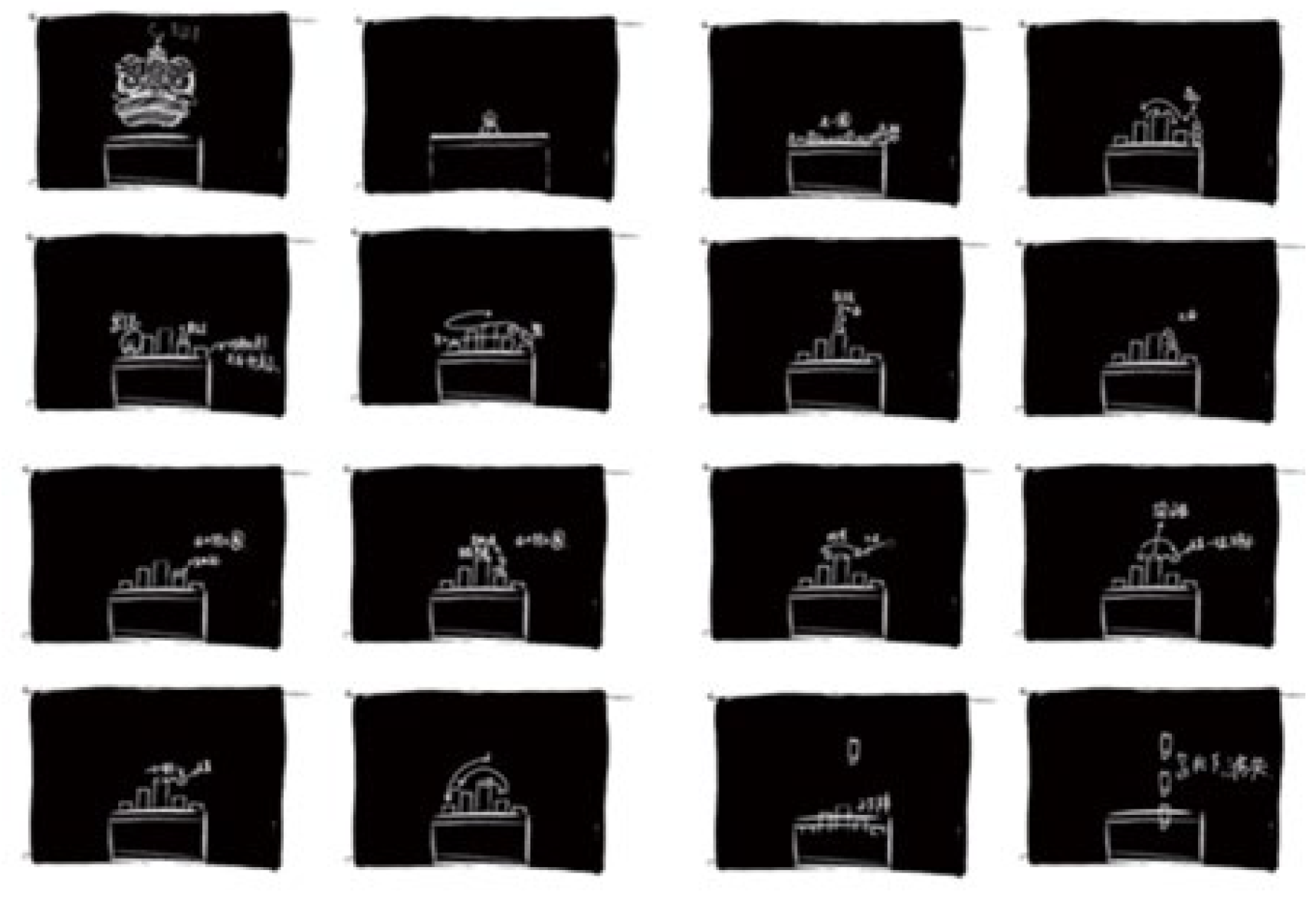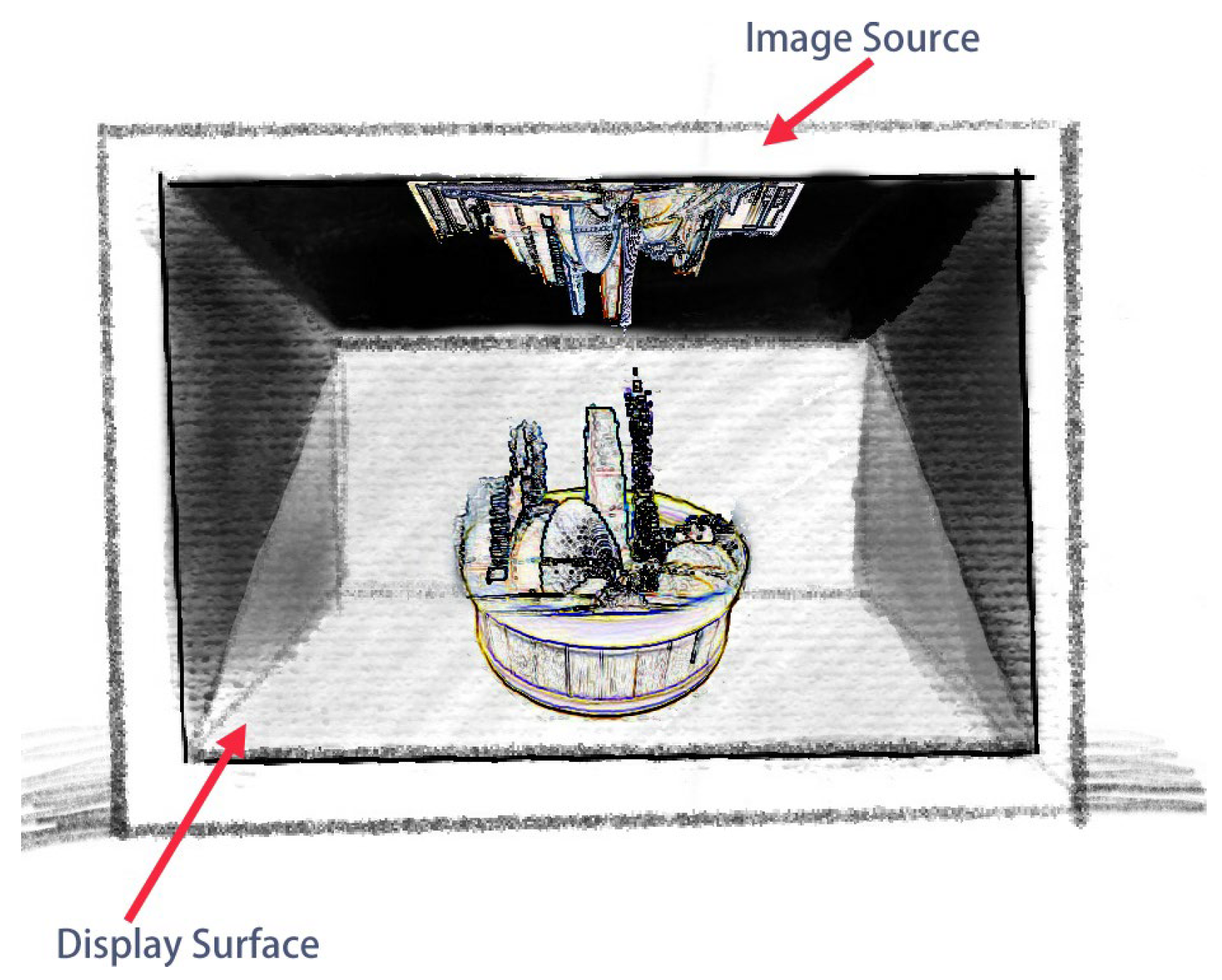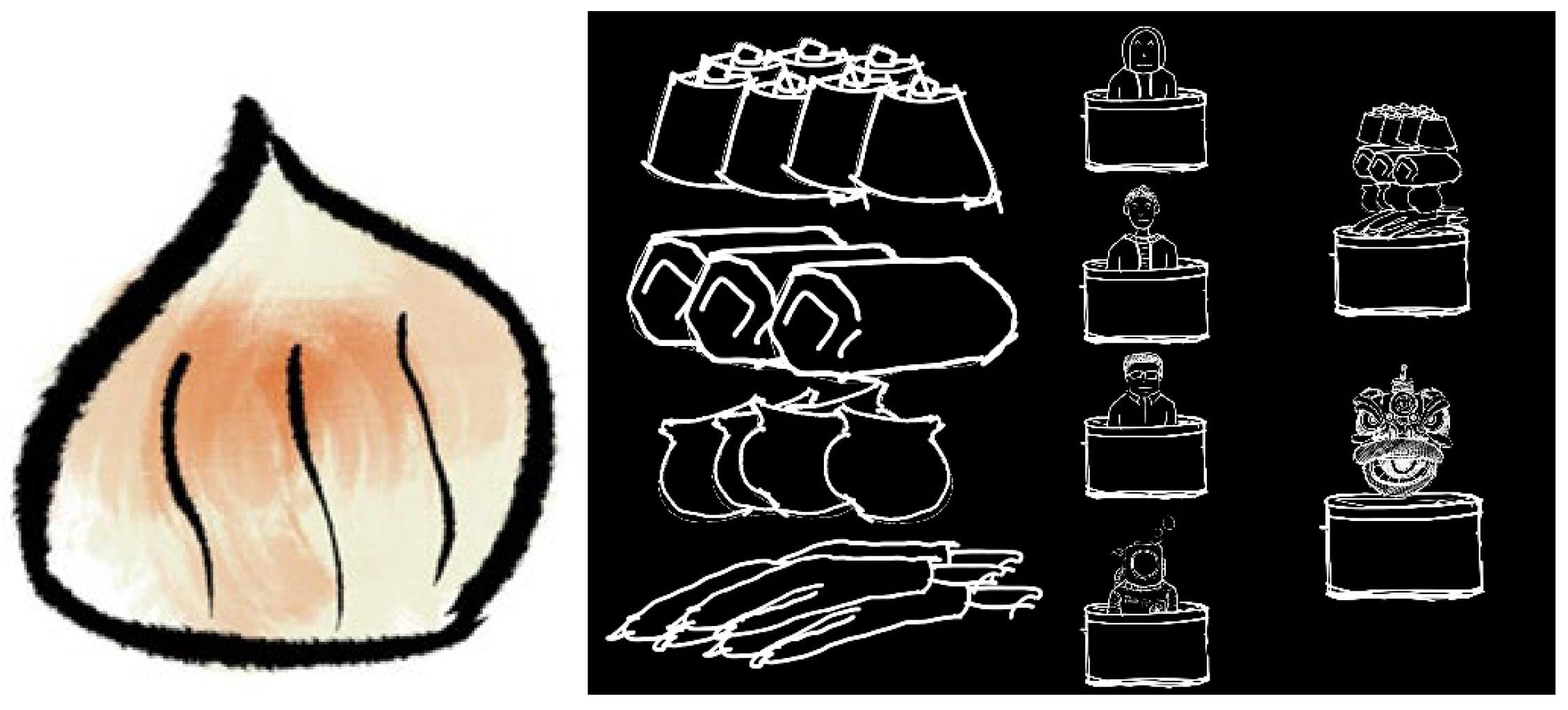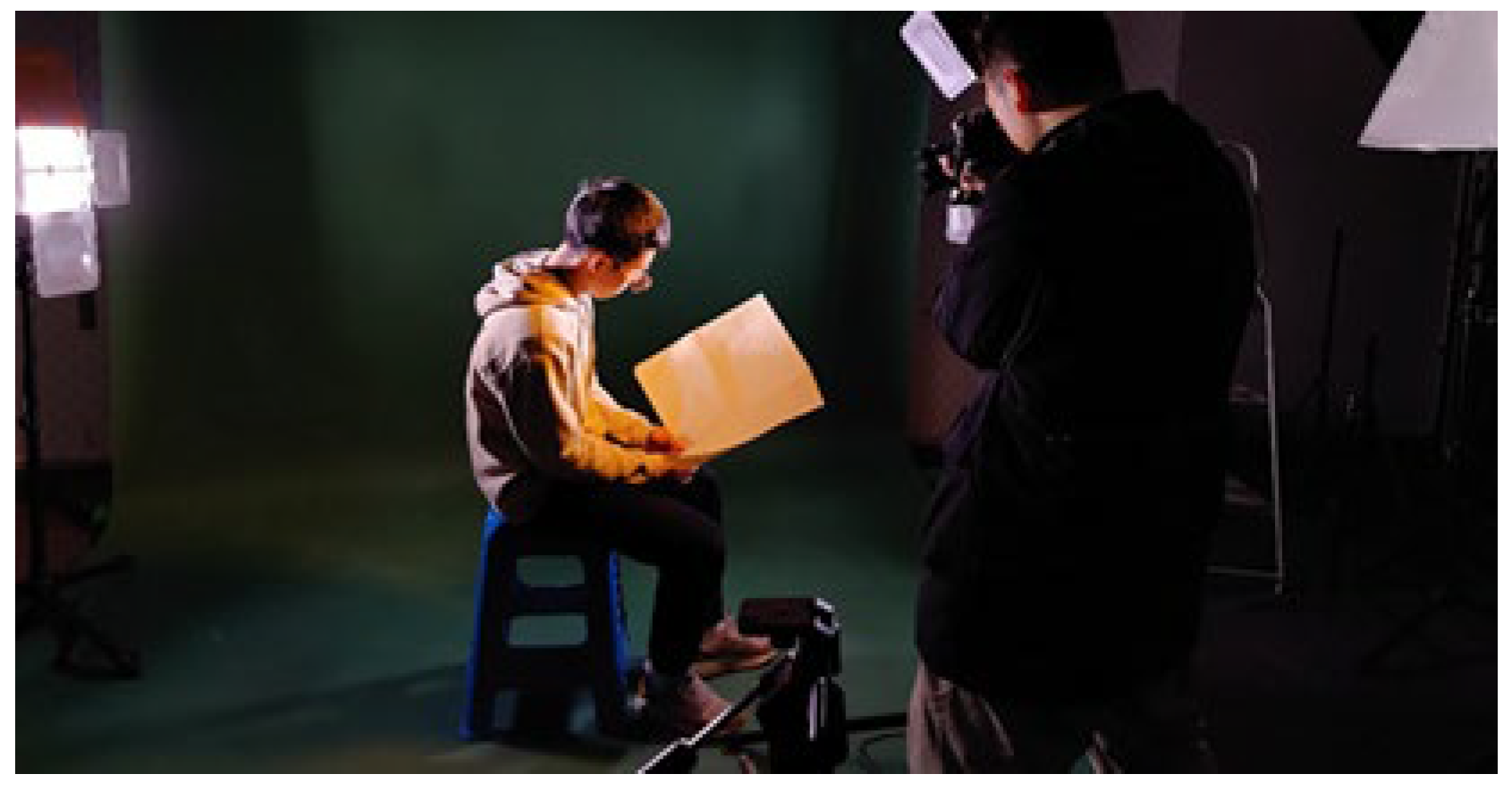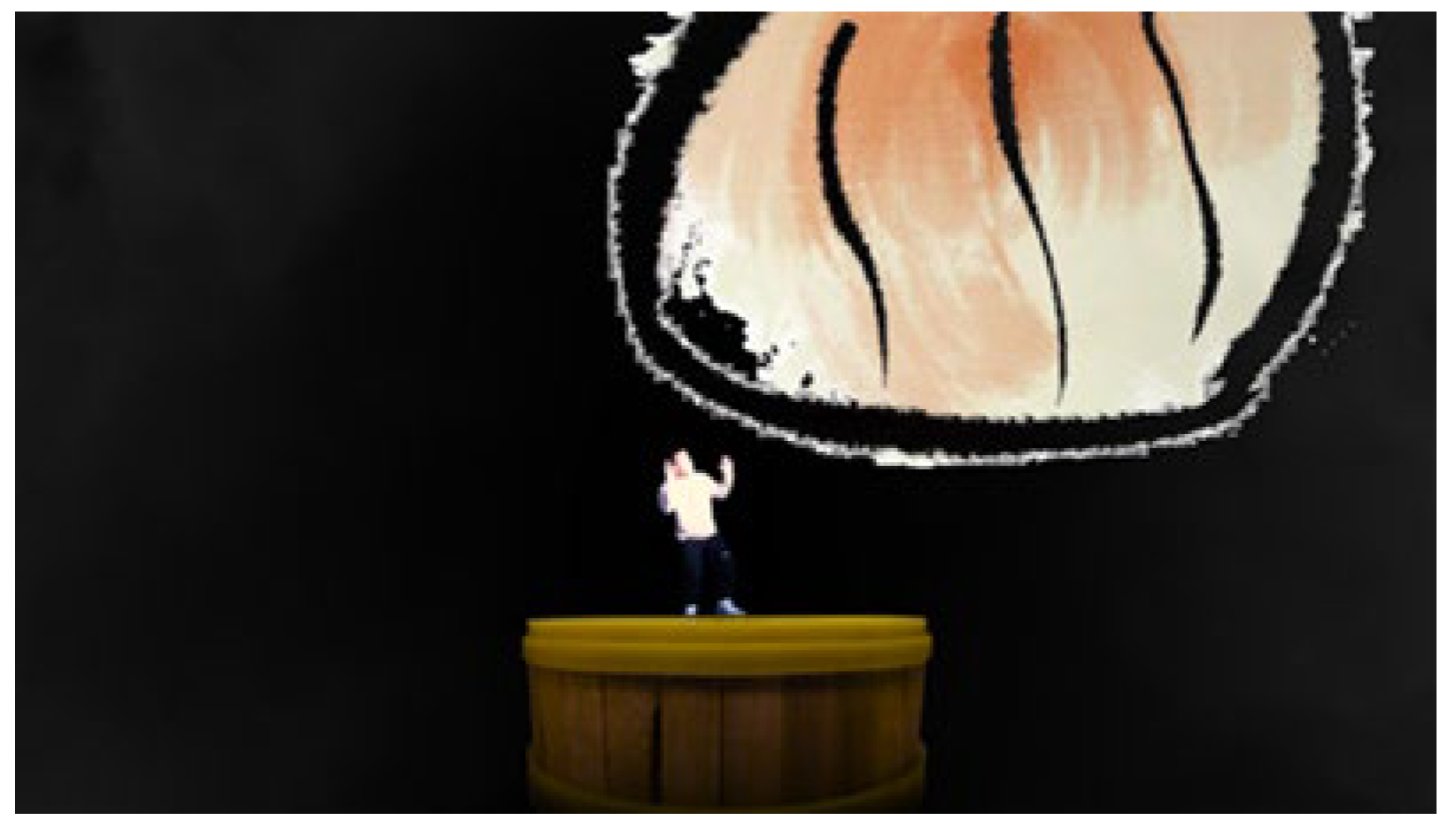1. Introduction
According to a Chinese saying, “Food is the people’s priority”. Food culture has long been seen as important in Chinese culture. During the last century, Guangdong, Hong Kong, and Macao of the Greater Bay Area (the GBA) in China have gradually embraced morning tea drinking into their daily lives. Cantonese morning tea drinking has become popular due to its sumptuous side dishes and relaxed market setting. Morning tea drinking is an important part of the culture of the Bay Area people despite the challenges of social advancement and urbanization. However, traditional tea businesses are facing difficulties in this modern era. Nevertheless, the majority of people in the GBA still appreciate the value of morning tea. As the modern and traditional versions of the morning tea experience differ in terms of dining options, cultural hubs, leisure activities, and other factors, there is an opportunity to embrace change and find ways to preserve the essence of morning tea while adapting to the changing times.
In today’s fast-paced digital world, it is important to keep up with the changing habits of the younger generation. While it may be challenging to encourage young people to adopt the practice of having morning tea, it is crucial to make it more appealing to them. Similarly, traditional tea houses need to adapt to the changing landscape and embrace new technologies to stay relevant. By utilizing central kitchens, pre-prepared meals, and other innovative methods, tea houses can serve their customers efficiently and effectively. It is important to balance between tradition and innovation to ensure that tea culture is preserved. The popularity of new media tools such as TikTok has provided the younger generation with an abundance of information and news. It is remarkable how easily accessible information is, enabling people to stay up to date with the latest news and social trends from their homes.
Thus, using the cutting-edge technology Pepper’s Ghost, we created an augmented reality (AR) Cantonese morning tea drinking experience to encourage pupils to share their stories. Additionally, the elements of Cantonese morning tea drinking were integrated into the video assets using a scripted story and young local actors, thereby promoting the local cultural heritage.
2. Literature Review
2.1. Study and Protection of Cantonese Morning Tea Drinking
The GBA is witnessing a surge in cultural research activities, thanks to the expanding coastal economy of China. While the study of morning tea drinking is not commonly known, relevant research findings have been published every year. Through a literature review, we compiled the latest research results regarding topics such as immigrant life, cultural identity, Cantonese culture, and cultural space. In a comparison study conducted over two decades ago, scholars found that children’s linguistic backgrounds played a significant role in their interactions. Thus, teachers must encourage communication between children of similar linguistic backgrounds to promote interactions between children from varied language backgrounds. These findings help us to understand communities better and create more inclusive spaces [
1]. Various research has been conducted on the hobbies and social networks of the population in the GBA, highlighting the role of Guangzhou-style morning tea drinking in helping immigrants feel more at home and integrated into Cantonese society, which leads to stronger social connections with locals and immigrants [
2]. Additionally, several Hong Kong scholars have researched traditional Cantonese tea culture to expand understanding of the history and current state of tea facilities. Overall, these studies provide information on the lifestyles and cultural practices of the people in the Greater Bay Area.
Researchers have highlighted the cultural significance of traditional cuisine and its experiential value for consumers. They emphasized the influence of Cantonese morning tea drinking in shaping the dining experience and how it continues to inspire similar meals [
3]. Additionally, the elements of the Cantonese morning tea drinking were integrated into artworks, showcasing the richness of traditional Cantonese culture. However, there are challenges faced by traditional Cantonese morning tea houses due to economic development, and there is an urgent need to preserve this cultural heritage and raise awareness about the importance of preserving and promoting traditional cultural practices [
4]. Cantonese morning tea drinking is popular and has seen an increased presence in restaurants despite its decline in teahouses. The cultural significance of Cantonese morning tea drinking, particularly in the GBA, was researched to understand how urban cultural space has evolved in the region with morning tea culture playing a crucial role in shaping it. The authors examined the potential for expanding urban cultural space based on the growth dimension of cultural space. Their findings help preserve and promote the cultural heritage of Cantonese morning tea drinking [
5].
2.2. Pepper’s Ghost and Augmented Reality (AR)
Pepper’s Ghost is an optical illusion. John explained its scientific principles in detail [
6]. The illusion has been successfully integrated into a European museum by an Italian research team, who designed holographic cabinets for improving visitor experience [
7]. Thomas explored the potential of Pepper’s Ghost and AR to examine social systems through media forms. He observed the current revival of Pepper’s Ghost as a promising way to create modern ‘holograms’ for the 21st century [
8]. Researchers in Spain developed a highly economical multi-view display using the Pepper’s Ghost technique. They encountered issues with the holographic display’s thickness, which made it difficult for users to read text, and its inability to perform well in bright light conditions. However, comparing the monitor with commercial optical field monitors, a multi-view display was developed [
9]. Pepper’s Ghost was used to create virtual presentations of large or delicate antiques in art museums. A device with sensors enables users to interact with the images using holographic displays and related applications [
10].
2.3. Three-Dimensional Modeling for Live Performance
Three-dimensional materials and various optical imaging technologies have been used to display cultural heritage content in recent years. Researchers combine live performances with cultural heritage by modeling cultural resources in three dimensions. Starting with manual modeling, semi-automatic computer-aided modeling is presently used with scanning drones to preserve and showcase cultural heritage [
11]. The potential of 3D modeling in cultural heritage education was researched by identifying three significant challenges to ensure the efficacy of digital 3D modeling technology. These challenges include usage scenarios and user cognition for technical processes and user experience, and legislation and infrastructure. Overcoming these challenges contributes to the preservation of traditional culture [
12]. Digital cultural treasures are accessible to visually impaired people by using interactive touch recognition techniques and traditional 3D scanning, modeling, and printing, which can be used to preserve and promote cultural heritage [
13]. Live broadcasts and e-commerce are also used to preserve intangible cultural property. These innovative approaches to preserving cultural heritage are crucial in ensuring that future generations continue to learn and appreciate rich cultural heritage [
14].
3. Study Design
3.1. Field Investigation
Although there are not many traditional Cantonese morning tea drinking businesses still in operation, the pandemic and quarantine regulations presented a unique opportunity for this research. Despite the challenges, we found six seafood restaurants serving Guangzhou-style morning tea in a three-kilometer radius (
Table 1). They were easily accessible, so thorough research could be conducted. They were selected from 15 restaurants by carefully filtering out unsuitable options and focusing on relevant venues. Many restaurants had irregular operating hours, which made it difficult to carry out an effective study. We found that the three restaurants had storefronts facing the street, which was their success factor. We selected the morning tea offered at “Li Yuan Seafood Restaurant” and sampled five morning tea delights to ensure accuracy and fairness. Shrimp dumplings were selected for the experiment.
3.2. Story Design
The story’s narrative structure started from the actors’ perspective and moved on to the third person (
Figure 1). With the help of Pepper’s Ghost technique, we created an immersive dream-like experience for viewers. The story is set in the GBA, where a young man embarks on an exciting adventure by ship. The story introduces the iconic Cantonese morning tea, which unexpectedly comes to life to communicate with the protagonist. The virtual scenes in the story show the prominent landmarks of the GBA, including the famous Dancing Lion to support the characters. The story is exciting and engaging and captures the essence of the GBA. The story serves traditional Cantonese morning tea. The characters’ dreams are displayed using a combination of real steamer props and computer-generated visuals. The protagonist, Brother Hao, and a virtual character named Shrimp Dumpling have a conflict, through which they introduce the principles of Cantonese morning tea drinking in a fun and engaging way. The story’s climax is a creative representation of the protagonist’s satiation with an endless supply of shrimp dumplings. The story is unique in showcasing the themes of traditional Cantonese morning tea culture. The story concludes when the protagonist is brought back to reality by the Dancing Lion. Pepper’s Ghost illusion, resembling a live performance, adds value to the tale. This type of storytelling is unique in terms of the performances it stages, setting it apart from popular movie and television scripts. We present an example of how similar the montage editing technique is to film and television works in this article. The limitations of technology for stage performances encourage creativity and uniqueness in the form and content.
3.3. Pepper’s Ghost Device
We developed a device prototype for the innovative Pepper’s Ghost illusion effect (
Figure 2). We used lightweight corrugated paper and white, translucent acrylic panels as the main structure for the device. To ensure high-quality imaging, we experimented with two imaging sources: a portable laser projector and a 27-inch LCD screen. The LCD screen provided a superior imaging effect for the experiment. We selected lightweight corrugated paper for the prototype’s main frame due to its affordability, ease of cutting, and wide availability. We created the prototype system to meet high standards. The projector’s surface is made of standard acrylic sheets as a reflective film. Shrimp dumplings and traditional Cantonese morning tea were used to test the system.
4. Results
4.1. Virtual Scenes
Virtual scenes were essential in the story development process for “Brother Hao”. These scenes were designed and rendered using digital tools to ensure that they appear in frame at the right moment (
Figure 3). We used the line draft technique to create realistic and detailed virtual scenes to help the audience be immersed in the hero’s dream world. Black with white lines presented a functional purpose by making use of the Pepper’s Ghost technique. This technique allowed the audience to see only the white-image information. When the black background was removed, a more realistic and immersive experience was obtained. Constructing the virtual scene’s material and animating it frame by frame took an enormous time. By introducing a video editing tool, the task was completed quickly and efficiently. We created the virtual character “Shrimp Dumpling” by freehand drawing in two dimensions for the resulting special effects. Colored avatars were more identifiable than standard visual elements to incorporate this.
4.2. Real-Scene Content
In the recorded live concert, LED lights were used for a better film effect. Two lights illuminated the green screen, and another two lights focused on the main character, which resulted in a more uniform green background (
Figure 4). The narrator’s Cantonese and the protagonist’s accent presented authenticity. Moreover, the protagonist treated the virtual character Shrimp Dumpling as if it were human for an engaging presence and live concert experience. There was no physical performance due to the character being virtual. The actor’s experience and skills were critical for delivering a good performance. Marionettes were also used for the lion dance. To ensure the best outcome, we created a skilled puppeteer to direct the motion of the lion dance (
Figure 5).
4.3. Digital Effects and Post-Editing
Once all the virtual video and live performance parts were recorded, the post-special effects were added and editing process commenced. For non-linear editing, Adobe Premiere 2018 was used, while Adobe Media Encoder 2018 was used for composite coding. We found that Adobe After Effects 2018 was the best post-production tool to bring all the elements together. The interactions between Brother Hao, the shrimp dumplings, and the Dancing Lion were challenging for special effects production. A real human needed to interact with the animation frame by frame. We animated the shrimp dumplings frame by frame in Adobe After Effects before importing the main character’s image with a transparent channel and producing a new video track. We combined the real person and the performance video with special effects. We edited the lion dance video using a transparent channel and then imported the video of the actual protagonist. After incorporating the scripted story, we applied the appropriate effects to each shot to make it visually appealing. Finally, we exported the edited video in 720 P MP4 format to enhance the overall quality of the video and make it more engaging for the audience (
Figure 6 and
Figure 7).
4.4. Pepper’s Ghost Device Assembling
We integrated accessibility and environmental protection via the use of Pepper’s Ghost technique. Corrugated paper was chosen as the principal structure of the imaging device because this study’s target population is lower-grade undergraduates and popular in colleges and universities. The basic structure sustained a 27” LCD. Load bearings were used for the experimental apparatus. Acrylic sheets were used as the imaging medium and mounted at a 45-degree angle by grooving the left and right cardboard edges. In the construction of the entire gadget, the steamer props were positioned in the center of the bottom. It was important to place the steamer in front of the clear acrylic plate for the image effect (
Figure 8).
5. Conclusions
To promote and meet the need for traditional Cantonese morning tea drinking, the establishment of culinary culture through its essence is important for the experience in dining and the cultural identity of locals. Cantonese morning tea drinking’s essence is inextricably linked to its physical form and the distinctive cultural setting of the GBA. The culture of Cantonese morning tea drinking must be passed down and needs to be enhanced with expression forms as cultural heritage. Even though traditional Cantonese morning tea drinking is disappearing, its superior culinary standards and distinctive cultural practices of “one cup and two pieces” must be preserved. Even though Pepper’s Ghost is an old technique with a history dating back more than a century, it still has a strong vitality even amongst new technologies like AR, virtual reality, and mixed reality. Even though human society has been at the threshold of the meta-universe, conventional 3D modeling technologies are used widely. The development of new media livestreaming platforms provides more e-commerce possibilities for intangible cultural heritage protection. In GBA, Pepper’s Ghost was used as the imaging technology to set up a real-life performance experiment platform for local young people’s cognition and emotional expression in this study.
In addition, there are limitations in the production of imaging devices. Live performances necessitate an upscaled studio and a larger venue compared to conventional 3D models. The Pepper’s Ghost device requires a space ten times smaller than studios, and its projections can be cast with synthetic clips of digitally hand-painted materials and live performance materials. The artists’ humanistic sentiments are added to the equivalent scale so that the virtual images can display cultural highlights on the real objects. This can be a way of ensuring traditional culture’s ongoing survival. The developed “light field” imaging device with improved imaging performance and larger interaction potential can be used for a wide range of research in the future.
Author Contributions
Conceptualization, S.X., P.-W.H., C.L. and J.-Y.Z.; methodology, S.X. and C.L.; software, S.X.; validation, S.X. and C.L.; formal analysis, S.X.; investigation, S.X. and J.-Y.Z.; resources, S.X. and P.-W.H.; data curation, S.X.; writing—original draft preparation, S.X. and C.L.; writing—review and editing, S.X. and C.L.; visualization, S.X., C.L. and J.-Y.Z.; supervision, C.L.; project administration, C.L. and P.-W.H.; funding acquisition, C.L. and P.-W.H. All authors have read and agreed to the published version of the manuscript.
Funding
This study was supported by the School of Design and Art, Beijing Institute of Technology, Zhuhai (ZX-2020-031) and the Department of Visual Arts, Macao Polytechnic University (RP/FAD-02/2022).
Institutional Review Board Statement
Not applicable.
Informed Consent Statement
Not applicable.
Data Availability Statement
Not available due to privacy restrictions.
Acknowledgments
We would like to extend our gratitude to the School of Design for their generosity in lending us the experiment venue and to Liang Yonghao and Zhou Meiyi who took time out of their busy schedules to participate in shooting the scenes and without whom this research would not have been completed successfully.
Conflicts of Interest
The authors declare no conflicts of interest.
References
- Oi-Ling Leung, L.; Lewis, G.F. The Effect of Ethnolinguistic Differences on Proximity between Cantonese and Mandarin Speaking Children. Early Child Dev. Care 1999, 159, 135–144. [Google Scholar] [CrossRef]
- Zhang, Y.; Long, M. The role of Yum Cha (Cantonese Morning Tea Drinking) in the integration process among interprovincial migration in China. Leis. Stud. 2015, 34, 59–66. [Google Scholar] [CrossRef]
- Chen, Z. A pilot study of the co-creation experience in traditional Cantonese teahouses in Hong Kong. J. Herit. Tour. 2018, 13, 506–527. [Google Scholar] [CrossRef]
- Liu, Y. Cantonese Cultural Center: Guangzhou China. Ph.D. Thesis, University of Georgia, Athens, GA, USA, 2019. [Google Scholar]
- Xudong, G.; Fang, C.; Xiaowen, F.; Haiming, C. Growth and Function of Urban Cultural Space Seen from Guangfu Morning Tea Culture. J. Landsc. Res. 2021, 13, 112–116. [Google Scholar]
- Greenslade Jr, T.B. Pepper’s Ghost. Phys. Teach. 2011, 49, 338–339. [Google Scholar] [CrossRef]
- Pietroni, E.; Ferdani, D.; Forlani, M.; Pagano, A.; Rufa, C. Bringing the illusion of reality inside museums—A methodological proposal for an advanced museology using holographic showcases. Informatics 2019, 6, 2. [Google Scholar] [CrossRef]
- Conner, T. Pepper’s Ghost and the AR of modernity. J. Sci. Pop. Cult. 2020, 3, 57–79. [Google Scholar] [CrossRef]
- Ezcurdia, I.; Arregui, A.; Ardaiz, O.; Ortiz, A.; Marzo, A. Content adaptation and depth perception in an affordable multi-view display. Appl. Sci. 2020, 10, 7357. [Google Scholar] [CrossRef]
- Andress, W. Virtual Presentation Methods for Physical Artifacts. Ph.D. Thesis, Worcester Polytechnic Institute, Worcester, MA, USA, 2022. [Google Scholar]
- Barrile, V.; Bernardo, E.; Bilotta, G. An experimental HBIM processing: Innovative tool for 3D model reconstruction of morpho-typological phases for the cultural heritage. Remote Sens. 2022, 14, 1288. [Google Scholar] [CrossRef]
- Muenster, S. Digital 3D Technologies for humanities research and education: An overview. Appl. Sci. 2022, 12, 2426. [Google Scholar] [CrossRef]
- Montusiewicz, J.; Barszcz, M.; Korga, S. Preparation of 3D models of cultural heritage objects to be recognised by touch by the blind—Case studies. Appl. Sci. 2022, 12, 11910. [Google Scholar] [CrossRef]
- Lu, Z.; Annett, M.; Fan, M.; Wigdor, D. “I feel it is my responsibility to stream” Streaming and Engaging with Intangible Cultural Heritage through Livestreaming. In Proceedings of the 2019 CHI Conference on Human Factors in Computing Systems, Glasgow Scotland, UK, 4–9 May 2019. [Google Scholar]
| Disclaimer/Publisher’s Note: The statements, opinions and data contained in all publications are solely those of the individual author(s) and contributor(s) and not of MDPI and/or the editor(s). MDPI and/or the editor(s) disclaim responsibility for any injury to people or property resulting from any ideas, methods, instructions or products referred to in the content. |
© 2024 by the authors. Licensee MDPI, Basel, Switzerland. This article is an open access article distributed under the terms and conditions of the Creative Commons Attribution (CC BY) license (https://creativecommons.org/licenses/by/4.0/).
